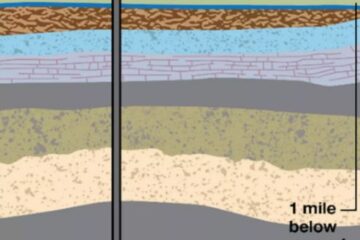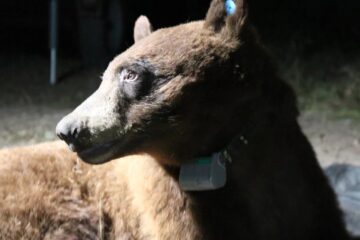Yosemite Debates the Nurturing of Nature
As the valley prepares to dedicate the biggest in a series of renovations, a lawsuit blocks some of the work.
Source of this article – Los Angeles Times, April 17, 2005.
 By Eric Bailey, Times Staff Writer
By Eric Bailey, Times Staff Writer
YOSEMITE NATIONAL PARK — Spawned by floodwaters and stalked by lawsuits, the long-awaited makeover of mankind’s structural imprint on the Yosemite Valley has kicked into high gear and is now delivering its first major results.
The biggest of several big-ticket projects is set for formal inauguration Monday as dignitaries dedicate the $13.5-million renovation of the beloved and crowded creek-side paths that serve as the front door to towering Yosemite Falls.
A week later, the park will formally welcome its new fleet of 18 diesel-hybrid buses, quieter and more fuel-efficient replacements for a ragtag collection of smog-belching predecessors. Meanwhile, the remodeled visitor’s center is open for business.
And for much of the coming summer, sightseers will have views not only of Half Dome and El Capitan but also of work crews toiling in trenches flanked by bright orange safety fence and of carpenters pounding nails into a new 217-bed employee dorm project at Curry Village.
Change is afoot in Yosemite. Once-bustling Northside Drive is shut down for a new sewage line project. Power and communications cables are being rerouted away from meadows. Even the ancient rock stairs to the base of Half Dome are being rebuilt.
Although every major attraction on the valley floor will remain accessible, it’s with a caveat: Pardon the dust and detours.
Yosemite officials have ruminated for decades over how to preserve the natural beauty of the valley while addressing the needs of 4 million visitors a year. Many valley buildings and much of the infrastructure date back half a century or more.
The remodeling process was hastened by a disastrous 1997 flood, which swamped buildings, tore out roads and ripped up campgrounds.
After years of delay and contentious wrangling over the valley’s development future, “it’s very satisfying” to see projects underway and completed, said Scott Gediman, Yosemite spokesman. “I hope what we accomplished so far on the ground shows the public the direction we’re going and what we hope to accomplish in the future.”
 But debate continues to echo over the fate of mile-wide Yosemite Valley.
But debate continues to echo over the fate of mile-wide Yosemite Valley.
A collection of park aficionados believes the various projects are overwrought, overpriced and intended to hasten the park’s final transformation into an ecological Disneyland, a place where pricey hotel rooms outnumber low-cost campsites 3 to 1.
“It’s all part of the yuppification of Yosemite,” said Angela Caldera, co-founder of Yosemite Campers Coalition. “They’re turning it into a wilderness Club Med catering to the affluent, a for-profit place more than a public park.”
Beauty in Yosemite Valley is very much in the eye of the beholder. The Yosemite Falls project, a decade in the making and almost entirely funded by the nonprofit Yosemite Fund, has generally won bravura reviews from early visitors.
“They did a really nice job,” said Mary Meuel, a Sacramento resident who recently visited the falls with her husband, kids and 84-year-old mom, Harriett, a Yosemite patron since her honeymoon at the park in 1949. “It does justice to trying to coexist with so much natural beauty.”
From the path’s entrance to the frothy foot of Yosemite Falls, renovations abound.
Gone is the bus-choked parking lot. Gone is cracked pavement. Gone is the grade school-style cinderblock bathroom.
Instead, there is a new roomy restroom of native granite and singular architecture. A new bus stop of boulders and hewn wood beams beckons sightseers. The parking lot has been replaced by a picnic spot. Fresh blacktop leads up a scenic corridor to the falls, at 2,425 feet the tallest in North America.
 Another asphalt path, longer and not as steep to accommodate folks with wheelchairs and walkers, meanders through groves of pine and incense cedar to the misty base of the Lower Yosemite Fall.
Another asphalt path, longer and not as steep to accommodate folks with wheelchairs and walkers, meanders through groves of pine and incense cedar to the misty base of the Lower Yosemite Fall.
The trails also tell stories. Placards posted along routes highlight history and ecology, telling tales of Native Americans and early pioneers. The site of John Muir’s long-gone cabin is pinpointed. A bronze relief provides a three-dimensional map of the waterfall’s geology.
Meuel’s two little girls spent five fascinated minutes examining the relief map. Her mom, who uses a walker, welcomed the smooth paths. Meuel loved the cul-de-sacs flanked by benches for contemplative respites.
Such reviews are music to Bob Hansen, president of the Yosemite Fund.
Hansen considers the falls a draw akin to India’s Taj Mahal and China’s Great Wall. With 2 million annual visitors making it the park’s most popular destination, Yosemite Falls deserves a beautiful path to its doorstep, Hansen said. “We needed to make sure when people arrived that they had this sense they were in a place like no other.”
The project marks the largest public-private venture in the park’s 115-year history. With $12.5 million in donations, the Yosemite Fund footed 90% of the final price tag. The nonprofit pooled 14,500 donations large and small, from million-dollar contributions to the pennies collected at a San Jose elementary school.
Hansen said the designer, venerable landscape architect Lawrence Halprin, spent days combing the construction site. Best known for the Franklin D. Roosevelt memorial in Washington, D.C., Ghirardelli Square and Sea Ranch’s clustered coastal housing north of San Francisco, Halprin is nearing 90. But he donned a hard hat and directed workers on even mundane tasks.
Most of the rock for walls and structures was recycled stone saved from the California Highway 140 reconstruction project a few years back. About 50 trees were felled to clear a path up the corridor, Hansen said, and others were trimmed with great care. Crews climbed into the branches with a chain saw and walkie-talkie. They’d shake a limb, cutting only if a spotter on the ground confirmed it would clear the view.
But what some see as progress and an improvement, others consider a step back.
“They are messing with Mother Nature,” said Caldera, a La Habra resident whose family first stayed at Lower Pines Campground after World War II. “Don’t they think the park on its own, the falls on their own, are enough to generate awe?”
Joyce Eden of Friends of Yosemite Valley suggests the park went over the top; she would have preferred far less grandiose improvement. She rues how boulders were uprooted and walls were built “like something you’d see on the Washington Mall.” She compares the bus stop structure to Stonehenge’s ominous slabs and dubs the new restroom “the abominable bathroom.”
 The eastern path, unpaved before the renovation, no longer affords people “their quiet experience” in a natural setting free of asphalt, Eden lamented. Meanwhile, new bridge footings dug 20 feet deep, she warned, threaten rivulets that wander from the waterfall’s base.
The eastern path, unpaved before the renovation, no longer affords people “their quiet experience” in a natural setting free of asphalt, Eden lamented. Meanwhile, new bridge footings dug 20 feet deep, she warned, threaten rivulets that wander from the waterfall’s base.
Protection of natural resources “has become secondary to the plans of the National Park Service to pave and commercialize Yosemite Valley,” concluded Eden, whose group is embroiled in a lawsuit that has halted several components of the valley’s $442-million face-lift.
The lawsuit has put some of the efforts — renovation of Yosemite Lodge, rerouting of traffic bottlenecks and other work — on hold. But one of the participants in the litigation, Bart Brown of Mariposans for the Environment and Responsible Government, noted that the Park Service has managed to win a judge’s approval to press ahead with construction work on multiple other fronts. He’s hardly thrilled.
“There’s orange netting everywhere,” he said. “It looks like Christo’s work in Central Park.”
Even the new buses have attracted a few catcalls.
Park officials say the buses’ combination of diesel and electric power will reduce emissions up to 60%. But doubters contend alternatives, such as propane, would have been far cleaner.
“They failed to seize an opportunity to become a leader,” said George Whitmore, the Sierra Club’s Yosemite chairman. “They wanted something safe and off the shelf. Instead of being pioneers, they came up short.”
Gediman said the Park Service considered other types of fuel for buses — natural gas, propane, fuel cells — and concluded that the best technology for the combination of steep climbs, hot summers and snowy winters would be diesel hybrid.
Others see a deeper philosophical question: whether Yosemite should let urban-style busing replace, as Brown put it, “a more dispersed private experience.”
“It seems to me,” Brown added, “the national parks experience should be a nature event.”


